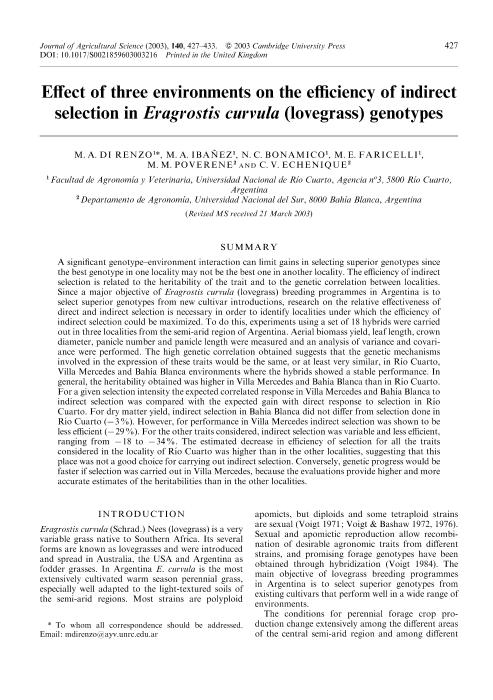Mostrar el registro sencillo del ítem
dc.contributor.author
Di Renzo, Miguel Angel

dc.contributor.author
Ibañez, M. A.
dc.contributor.author
Bonamico, Natalia Cecilia

dc.contributor.author
Faricelli, M. E.
dc.contributor.author
Poverene, María Mónica

dc.contributor.author
Echenique, Carmen Viviana

dc.date.available
2018-01-18T18:16:01Z
dc.date.issued
2003-06
dc.identifier.citation
Di Renzo, Miguel Angel; Ibañez, M. A.; Bonamico, Natalia Cecilia; Faricelli, M. E.; Poverene, María Mónica; et al.; Effect of three environments on the efficiency of indirect selection in Eragrostis curvula (lovegrass) genotypes; Cambridge University Press; Journal Of Agricultural Science; 140; 4; 6-2003; 427-433
dc.identifier.issn
0021-8596
dc.identifier.uri
http://hdl.handle.net/11336/33821
dc.description.abstract
A significant genotype environment interaction can limit gains in selecting superior genotypes since the best genotype in one locality may not be the best one in another locality. The efficiency of indirect selection is related to the heritability of the trait and to the genetic correlation between localities.Since a major objective of Eragrostis curvula (lovegrass) breeding programmes in Argentina is to select superior genotypes from new cultivar introductions, research on the relative effectiveness of direct and indirect selection is necessary in order to identify localities under which the efficiency of indirect selection could be maximized.To do this, experiments using a set of 18 hybrids were carried out in three localities from the semi-arid region of Argentina. Aerial biomass yield, leaf length, crown diameter, panicle number and panicle length were measured and an analysis of variance and covariance were performed. The high genetic correlation obtained suggests that the genetic mechanisms involved in the expression of these traits would be the same, or at least very similar, in Rı´o Cuarto, Villa Mercedes and Bahı´a Blanca environments where the hybrids showed a stable performance. In general, the heritability obtained was higher in Villa Mercedes and BahÍa Blanca than in Rıo Cuarto. For a given selection intensity the expected correlated response in Villa Mercedes and BahÍa Blanca to indirect selection was compared with the expected gain with direct response to selection in Rıo Cuarto. For dry matter yield, indirect selection in Bahı´a Blanca did not differ from selection done inRı´o Cuarto (x3%). However, for performance in Villa Mercedes indirect selection was shown to be less efficient (x29%). For the other traits considered, indirect selection was variable and less efficient,ranging from x18 to x34%. The stimated decrease in efficiency of selection for all the traits considered in the Locality of RÍo Cuarto was higher than in the other localities, suggesting that this place was not a good choice for carrying out indirect selection. Conversely, genetic progress would be faster if selection was carried out in Villa Mercedes, because the evaluations provide higher and more accurate estimates of the heritabilities than in the other localities.
dc.format
application/pdf
dc.language.iso
eng
dc.publisher
Cambridge University Press

dc.rights
info:eu-repo/semantics/openAccess
dc.rights.uri
https://creativecommons.org/licenses/by-nc-sa/2.5/ar/
dc.subject
Indirect Selection
dc.subject
Lovegrass Genotypes
dc.subject
Efficiency
dc.subject.classification
Otras Biotecnología Agropecuaria

dc.subject.classification
Biotecnología Agropecuaria

dc.subject.classification
CIENCIAS AGRÍCOLAS

dc.title
Effect of three environments on the efficiency of indirect selection in Eragrostis curvula (lovegrass) genotypes
dc.type
info:eu-repo/semantics/article
dc.type
info:ar-repo/semantics/artículo
dc.type
info:eu-repo/semantics/publishedVersion
dc.date.updated
2017-12-12T19:57:31Z
dc.journal.volume
140
dc.journal.number
4
dc.journal.pagination
427-433
dc.journal.pais
Reino Unido

dc.journal.ciudad
Cambridge
dc.description.fil
Fil: Di Renzo, Miguel Angel. Universidad Nacional de Río Cuarto. Facultad de Agronomía y Veterinaria; Argentina
dc.description.fil
Fil: Ibañez, M. A.. Universidad Nacional de Río Cuarto. Facultad de Agronomía y Veterinaria; Argentina
dc.description.fil
Fil: Bonamico, Natalia Cecilia. Universidad Nacional de Río Cuarto. Facultad de Agronomía y Veterinaria; Argentina. Consejo Nacional de Investigaciones Científicas y Técnicas; Argentina
dc.description.fil
Fil: Faricelli, M. E.. Universidad Nacional de Río Cuarto. Facultad de Agronomía y Veterinaria; Argentina
dc.description.fil
Fil: Poverene, María Mónica. Universidad Nacional del Sur. Departamento de Agronomía; Argentina. Consejo Nacional de Investigaciones Científicas y Técnicas. Centro Científico Tecnológico Conicet - Bahía Blanca. Centro de Recursos Naturales Renovables de la Zona Semiárida. Universidad Nacional del Sur. Centro de Recursos Naturales Renovables de la Zona Semiárida; Argentina
dc.description.fil
Fil: Echenique, Carmen Viviana. Universidad Nacional del Sur. Departamento de Agronomía; Argentina. Consejo Nacional de Investigaciones Científicas y Técnicas. Centro Científico Tecnológico Conicet - Bahía Blanca. Centro de Recursos Naturales Renovables de la Zona Semiárida. Universidad Nacional del Sur. Centro de Recursos Naturales Renovables de la Zona Semiárida; Argentina
dc.journal.title
Journal Of Agricultural Science

dc.relation.alternativeid
info:eu-repo/semantics/altIdentifier/url/https://www.cambridge.org/core/journals/journal-of-agricultural-science/article/effect-of-three-environments-on-the-efficiency-of-indirect-selection-in-eragrostis-curvula-lovegrass-genotypes/1252AC3EBCD65A6D30047F13FBAEDA26
dc.relation.alternativeid
info:eu-repo/semantics/altIdentifier/doi/http://dx.doi.org/10.1017/S0021859603003216
Archivos asociados
